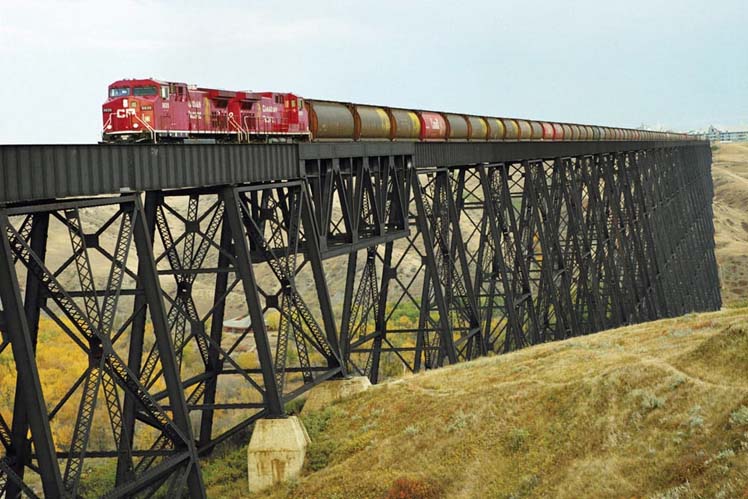
Western Canada - Joan Hardy knows how vital reliable rail service is to grain shippers because she's been one.
Hardy, who became CP's vice-president of sales and marketing for grain and fertilizer 1 Apr 2018 was for 12 years before that Richardson International's
vice-president of transportation.
Before that she worked 21 years for CN, in various roles, including assistant vice-president, sales and senior director in CN's customer service
centre.
"The grain shippers really rely on us," Hardy said in an interview 6 Sep 2018.
"The relationship we have with them is very important. I know that my intention is to help our customers thrive and to help them grow. And I know we can
be an enabler of that growth."
The Western Grain Elevator Association (WGEA), whose member-companies ship most of Western Canada's grain to export, has long complained not only that CP and
CN sometimes fail to deliver the cars they promised on time, but most years don't even come close to offering the 18,470 cars a week companies say they would
ship between October and March, the peak grain-moving period, if they were available.
The railways have committed this crop year to deliver 5,500 cars a week each during the non-winter months and 4,000 a week each during the winter.
That's about half of what WGEA executive director Wade Sobkowich says grain companies have the capacity to handle.
"I respect that is the opinion," Hardy said.
"I'm not saying I don't think it's true. It is possible that kind of movement could happen, but it certainly would not be the most effective way for all
of these very capital-intensive assets we all have."
Typically around 40 million tonnes of western Canadian grain are shipped by rail annually.
If the railways shipped more than 18,000 cars a week most years the entire crop would be moved in five months, she added.
"That would leave an entire industry completely idled for the balance of the year, including a lot of our assets," Hardy said.
"I don't know that would be an effective model for an entire industry to follow. My experience would say that supply chains work most effectively when
they are steady-state operations. Just like we all understand 24-7 makes operational sense. I think a rather steady-state flow is what is going to really
create the most capacity for the industry."
Suggesting the system could move 18,000 grain cars a week isn't practical, David Przednowek, CN's director of grain marketing, said in an interview
24 Aug 2018.
"It's one thing to build nameplate capacity and then make an assumption that capacity can run 100 percent efficient seven days a week, 24 hours a day,
over the course of the year, and that there will actually be market demand for the utilization of that capacity," Przednowek said.
"What CN has provided is what it can realistically handle on a sustained basis both outside of winter and during winter."
According to Sobkowich, if rail service was truly competitive grain shippers would get the cars when they want them, even if it meant idling rail capacity part
of the year.
Grain shippers contend they are captive to the railways, a point Hardy made while at Richardson while speaking at the Canadian Global Crops Symposium in
Calgary 11 Apr 2017.
"Exports can only happen with rail service," Hardy said, pointing out grain exports during the 2013-2014, 2014-2015, and 2015-2016 crop years on
average were up 25 percent compared to the five years previous.
"Just about all of those exports included in those numbers are moving by rail to the ports."
Back then Hardy also predicted the upward trend in western Canadian grain production would continue averaging two to 2.5 percent annually.
"With that we could see a 90 million tonne crop 15 years from now," she said last year.
"That's about 25 million tonnes more than we've seen over the last four years."
CP is ready to move this year's crop and handle future growth too, Hardy said last week.
This year's 5,500 and 4,000 car-per-week commitment is up six to eight percent from CP's 2017-2018 commitment.
For example, the railway has been lengthening its 7,000 foot sidings to handle 8,500 foot grain trains, she said.
It won't happen all at once, but over time, longer trains pulling higher-capacity cars, will expand CP's grain-moving capacity by almost 44 percent, she
said.
"Relative to five years ago we are moving 20 percent more car loads so there has been a steady increase in CP capacity already," Hardy
said.
"With our new fleet of high-capacity cars and 8,500 foot trains it's like another step function change."
With the Transportation Modernization Act (Bill C-49) becoming law earlier this year CP announced it's spending $500 million to buy 5,900 shorter, but bigger
cars that can carry 10 percent more grain by weight and 20 percent more by volume.
CP will receive the first 500 of those cars next month, another 500 in early 2019, and the rest over the next 3 1/2 years.
CP has typically run 7,000 foot trains with 112 cars.
When the new, shorter, but higher-capacity cars come on stream, CP will pull 118 cars.
"Right there means an increase of about 15 percent more grain on every car," Hardy said.
The step is 134 car trains followed by 8,500 foot (1.6 mile) trains pulling 147 cars, she added.
New elevators are being built for the longer trains and many older ones are being refurbished to handle them.
"Today we carry about 10,500 tonnes of grain per train," Hardy said.
"With our current train length with the new cars we'll carry about 12,000 tonnes of grain per train. With our longer train length and the new cars we'll
carry 15,000 tonnes of grain per train. It's really a significant capacity lift for the grain industry."
CP is also investing in new locomotives and has hired and is training 700 new employees.
"We're excited about the fall," Hardy said.
"We're excited about the future. We've set our plans this fall to run as many of our trains as possible, certainly in some geographies, with a power-on
model that will ensure that we've got locomotives ready to pull the trains when they are loaded. So it's going to be a combination of power-on and what we call
drop-lift so that either the locomotive will stay with the train or there will be a locomotive that comes timed perfectly for when the train is released. With
that we are anticipating a very good, fluid move through the fall."
Allan Dawson.
provisions in Section 29 of the Canadian
Copyright Modernization Act.

